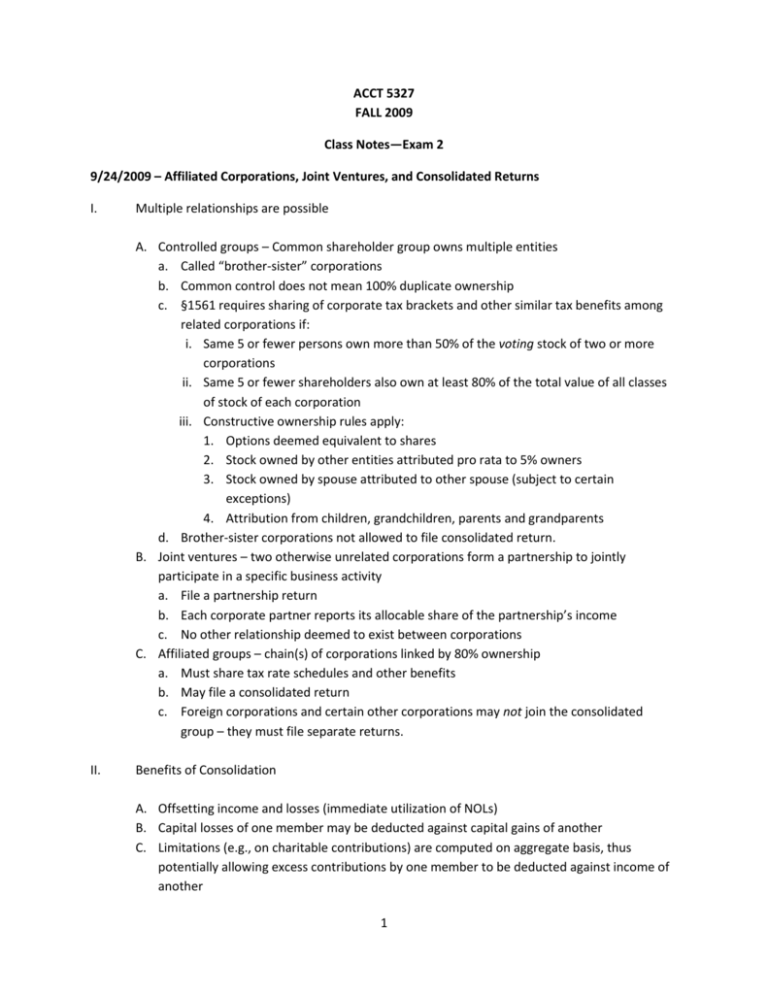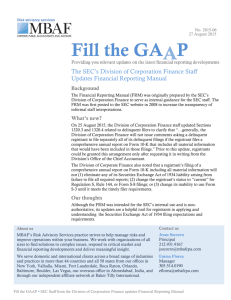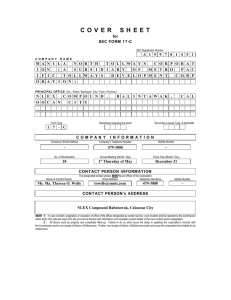ACCT 5327 FALL 2009 Class Notes—Exam 2 9/24/2009 – Affiliated
advertisement

ACCT 5327 FALL 2009 Class Notes—Exam 2 9/24/2009 – Affiliated Corporations, Joint Ventures, and Consolidated Returns I. Multiple relationships are possible A. Controlled groups – Common shareholder group owns multiple entities a. Called “brother-sister” corporations b. Common control does not mean 100% duplicate ownership c. §1561 requires sharing of corporate tax brackets and other similar tax benefits among related corporations if: i. Same 5 or fewer persons own more than 50% of the voting stock of two or more corporations ii. Same 5 or fewer shareholders also own at least 80% of the total value of all classes of stock of each corporation iii. Constructive ownership rules apply: 1. Options deemed equivalent to shares 2. Stock owned by other entities attributed pro rata to 5% owners 3. Stock owned by spouse attributed to other spouse (subject to certain exceptions) 4. Attribution from children, grandchildren, parents and grandparents d. Brother-sister corporations not allowed to file consolidated return. B. Joint ventures – two otherwise unrelated corporations form a partnership to jointly participate in a specific business activity a. File a partnership return b. Each corporate partner reports its allocable share of the partnership’s income c. No other relationship deemed to exist between corporations C. Affiliated groups – chain(s) of corporations linked by 80% ownership a. Must share tax rate schedules and other benefits b. May file a consolidated return c. Foreign corporations and certain other corporations may not join the consolidated group – they must file separate returns. II. Benefits of Consolidation A. Offsetting income and losses (immediate utilization of NOLs) B. Capital losses of one member may be deducted against capital gains of another C. Limitations (e.g., on charitable contributions) are computed on aggregate basis, thus potentially allowing excess contributions by one member to be deducted against income of another 1 D. Intercompany gains are deferred until property is disposed of outside the group E. Distributions between members are nontaxable III. Disadvantages of Consolidation A. Complexity B. Loss limitations are quite stringent 09/29/2009 – Acquisition of subsidiaries IV. Formation of joint venture with another taxpayer (typically another corporation) A. E.g., Chevron and Exxon may form a joint venture to explore and/or develop an offshore oil & gas lease B. Essentially, the joint venture is a separate partnership C. Sec. 721: No gain or loss is recognized on contribution of property for an interest in capital and profits of the partnership/joint venture D. Sec. 722: Partners take substitute basis in their partnership interest equal to: a. Basis of property contributed to joint venture b. Less liabilities transferred to and assumed by the joint venture c. Plus share of jv liabilities for which partner is indirectly responsible E. Sec. 723: JV takes carryover basis in property contributed by a partner in a transaction governed by Sec. 721 F. Subsequent operations of Joint Venture— a. Each partner reports its share of joint venture income or loss each year, whether or not distributed by JV to such partner; b. Basis in JV is adjusted as follows: i. Increase by share of gain/income ii. Decrease by share of loss iii. Decrease (but not below zero) by distributions received V. Formation of new subsidiary via contribution of property A. Sec. 351: No gain or loss is recognized on contribution of property for stock in a controlled corporation a. 351(b)—gain, but not loss is recognized if transferor receives property other than stock in the new corporation. Gain recognized equals the lesser of: i. Gain realized on exchange; or ii. FMV of “boot” received b. Debt assumed by transferee corporation is not treated as boot unless incurred by transferor in anticipation of transfer to corporation. 2 B. Sec. 358: Contributing shareholder takes substitute basis in stock received equal to: a. Basis of property transferred b. Less FMV of boot received c. Less debt transferred to corporation d. Plus gain recognized by transferor C. Sec. 362: Transferee corporation takes carryover basis in property(ies) received from transferor, increased by gain, if any, recognized by transferor. D. Subsequent operations of new sub— a. If new sub joins consolidated group, parent reports all income/loss of subsidiary on consolidated return b. Parent’s basis in subsidiary stock is adjusted as follows: i. Increase by income reported on consolidated return ii. Increase by tax-exempt income received by subsidiary iii. Decrease by expenses deducted on consolidated return iv. Decrease by nondeductible expenses incurred by subsidiary v. Increase by subsidiary’s share of taxes paid by parent on sub’s behalf (and not reimbursed by sub) vi. Decrease by distributions received from subsidiary (except for reimbursement of subsidiary’s share of taxes—treated as a nondeductible expense of the sub paid to IRS, rather than to parent) 10/06/2009 – Limitations on Loss Carryforwards (and built-in losses) VI. Sec. 382—imposes limitation on utilization of NOL c/fs following “change in ownership” A. Change in ownership is defined as change in shares owned by “5-percent” shareholders increases by 50 percentage points over a 12-month period B. 5-percent shareholder is a shareholder that owns 5% or more of the corporation’s outstanding shares VII. Sec. 382(b)—limitation is equal to: A. “Value” of “old loss corporation” multiplied by B. Long-term tax exempt rate (published by IRS monthly) VIII. Sec. 382(b)(2)—limitation is cumulative IX. Sec. 382(b)(3)—where change in ownership occurs in middle of year: A. limitation is pro-rated to period of year following change in ownership B. limitation does not apply to portion of year preceding ownership change 3 X. Sec. 382(h)—effect of net unrealized gains or losses inherent in corporation’s balance sheet as of date of ownership change: A. Net unrealized built-in gains may be offset by NOL c/fs without regard to Sec. 382 a. When unrealized gains are recognized for tax purposes, limitation is increased in a like amount for year of recognition b. Increase may not exceed initial net unrealized gain, reduced by gains recognized in prior years B. Net unrealized built-in losses treated as “pre-change losses”—i.e. as part of the NOL c/f a. Thus, as these losses are realized, they can be deducted only to the extent of the limitation over the NOL c/f deducted in realization year. b. Limitation applies to losses realized within 5 years of the change in ownership. (382(h)(7)) C. Sec. 382(h)(3)(B)—under a de minimis rule, built-in gains or losses are deemed to equal zero if they are less than 15% of the FMV of corporate assets or $10,000,000, whichever is less. 10/08/2009 – Basis Adjustments XI. Joint Venture Interest A. Sec. 722—Initial basis: a. Cash invested in joint venture b. Plus tax basis of property contributed c. Minus liabilities transferred to JV d. Plus share of JV debt e. Plus gain recognized (if any) B. Sec. 705—Effect of subsequent operations: a. Basis increased by share of income or gain, including nontaxable income b. Basis decreased, but not below zero, by share of expense or loss, including nondeductible expenditures c. Basis increased by subsequent contributions of cash or property, including increases in share of JV liabilities d. Basis decreased, but not below zero, by distributions received from JV, including decreases in share of liabilities C. Sec. 704(d)—Losses in excess of basis are not allowed, but may be carried forward until taxpayer has sufficient basis to absorb them D. Sec. 731—Distributions generally nontaxable unless they exceed basis (more discussion next week) XII. Parent investment in subsidiary stock in consolidated return 4 A. Regs. §1.1502-32 provides a similar system for consolidated groups: a. Basis increased or decreased by subsidiary’s taxable income or loss i. Calculated by reference to subsidiary income or loss included in the calculation of consolidated taxable income ii. EXAMPLE b. Basis increased by subsidiary’s tax-exempt income i. Deductions that do not reduce subsidiary’s tax basis in its assets are treated as tax-exempt income: ii. Dividends received deduction iii. Section 199 deduction c. Basis reduced by subsidiary’s noncapital, nondeductible expenses, including subsidiary’s share of consolidated income tax liability d. Basis reduced by distributions received from subsidiary B. Basis in subsidiary stock can be reduced below zero a. Creates “excess loss” account b. Must be recaptured into income upon sale of subsidiary stock C. Carryback and carryforward losses generated by a subsidiary reduce tax basis of subsidiary stock to extent such losses are actually utilized by the consolidated group a. Carry backs reduce basis in the year the loss was generated (i.e., current year) b. Carry forwards reduce basis in the year the loss is utilized (i.e., future year) D. Taxes a. Generally treated as nondeductible, noncapital expenditure by subsidiary (thus reducing basis of sub stock) b. If paid by parent, reduction is offset by deemed contribution to subsidiary—i.e., sub deemed to have paid the taxes (reducing parent’s stock basis), followed by contribution by parent to sub to reimburse such payment (increasing parent’s stock basis) c. Result of b above is to make irrelevant any differences between regs’ allocation of tax liability and tax-sharing agreements by members of group (difference between technical allocation and actual allocation is deemed paid by either parent or sub, and treated as a distribution/contribution, washing out effect of difference on stock basis) d. EXAMPLE: Assume the following income or loss for the PSS Group: P S1 S2 Income/(loss) 1,000 (500) 2,000 Tax (at 35%) Allocation—1502 (350) 175 (700) Actual payments* (292) 0 (583) Deemed contributions: S1 to P (175) 5 Consol 2,500 (875) P to S2 Net basis adjustments: Allocated tax Deemed contributions 117 175 (175) 0 (700) 117 (583) * Assume tax sharing agreement allocates actual tax liability among members based on their positive contributions to consolidated taxable income. Note that the net adjustments exactly equal the amounts paid by subs under tax sharing agreement. 10/15/2009 – Distributions XIII. Distributions Received in Connection with Continuing Interest in a Joint Venture (Partnership) A. Sec. 731(a)(1)—Gain recognized by a partner on receipt of a distribution from the partnership only to the extent that the amount of money received exceeds partner’s basis in the partnership interest. B. Sec. 732(a)—Partner takes carryover basis in property received as a non-liquidating distribution from partnership a. Exception—basis of property received may not exceed partner’s tax basis in partnership interest. b. Where partner receives a distribution of cash and property, cash is treated as received first. c. Reduction in partner’s share of liabilities (e.g., as a result of reduction in partner’s interest in partnership following receipt of the distribution) is treated as a distribution of money to the partner (Sec. 752(b)). C. Sec. 733—Partner reduces its basis in partnership interest, but not below zero, by amount of money and tax basis of property received in distribution. D. Sec. 752(a)—Liabilities assumed by partner in connection with distribution (as when property received in distribution is encumbered by a mortgage) are treated as a transfer of money by the partner to the partnership immediately prior to receipt of the distribution. XIV. Distributions Received in Liquidation of an Interest in a Joint Venture (Partnership) A. Sec. 731(a)(1)—Gain not recognized unless partner receives cash in excess of basis of partnership interest B. Sec. 731(a)(2)—Loss may be recognized, but only if the distribution consists solely of cash and/or ordinary income property (e.g., inventory) with an aggregate face value/tax basis that is less than the partner’s basis in the partnership interest. C. Sec. 732(b)—Basis in property received in liquidation of partner’s interest in the partnership is equal to partner’s basis in such partnership interest immediately prior to receipt of the 6 distribution, reduced by money (including reduction in share of liabilities) received as part of the distribution. D. Sec. 732(c)(1)(A)(i)—basis of ordinary income property received may not be increased above its basis to the partnership prior to receipt of the distribution (thus, the ability to deduct losses when basis of such property is less than partner’s basis in partnership interest). XV. Distributions Received by Shareholder from Corporation in Which S/H Owns Stock A. Sec. 301(c)—distributions are taxable to shareholder as dividend income to the extent of distributing corporation’s “earnings & profits” (E&P). a. Distributions in excess of E&P reduce tax basis of recipient in stock of distributing corporation. b. Regs. §1.1502-13(f)—Dividends received from another member of consolidated group are not taxable (and thus reduce basis in stock of distributing corporation). B. E&P are essentially equal to taxable income adjusted for : a. Nontaxable income (e.g., dividends received deduction, section 199 deduction, dividends received from another member of consolidated group); b. Nondeductible losses and expenditures (e.g., fines & penalties, 50% of meals & entertainment, income tax expense); c. Excess losses and expenditures (e.g., capital losses in excess of capital gains, charitable contributions in excess of 10% limitation, net operating losses); d. Methodological adjustments (depreciation methods, etc.). C. E&P is computed on cumulative basis (like retained earnings) and is reduced by distributions deemed to come from E&P (also like retained earnings). D. E&P of consolidated group is aggregated for purposes of classifying distributions from parent to ultimate shareholders. XVI. Corporate Distribution of Property Other than Cash A. Sec. 301(b)—amount of distribution is equal to net FMV of property received. B. Sec. 301(d)—shareholder takes basis in distributed property equal to FMV. C. Sec. 311(a)—no gain or loss recognized by corporation on distribution with respect to its stock. D. Sec. 311(b)—Exception: distributing corporation recognizes gain on distribution of appreciated property as if such property were sold and the proceeds distributed to shareholder(s) E. Regs. §1502-13—distributions between members of a consolidated group: a. Sec. 311(a) does not apply—distribution of property to another member of consolidated group is treated as a sale, followed by distribution of proceeds b. corporation recognizes gain or loss on distribution equal to difference between basis and FMV 7 c. Recipient takes FMV basis in property received d. Gain or loss is not eliminated in consolidation XVII. Redemptions A. Sec. 302—Stock redemption triggers capital gain to extent proceeds exceed basis of redeemed shares a. All gain to s/h is capital, even though a portion of proceeds may reflect E&P attributable to redeemed shares b. E&P is reduced proportionate to portion of shares redeemed (i.e., redemption of 20% of outstanding shares reduces E&P by 20%, even though s/h recognizes no dividend income). B. Treatment only applies to qualified redemptions as defined in Sec. 302: a. Redemptions not “essentially equivalent to dividends” b. Substantially disproportionate redemptions: i. At least 20% reduction in s/h’s direct and indirect interest in corporation ii. S/h owns, directly and indirectly, less than 50% of outstanding shares following transaction c. Partial liquidations (distributions attributable to disposition of a qualified line of business of corporation) d. Complete liquidation of s/h’s interest e. Sec. 303—redemptions to pay estate taxes 8





